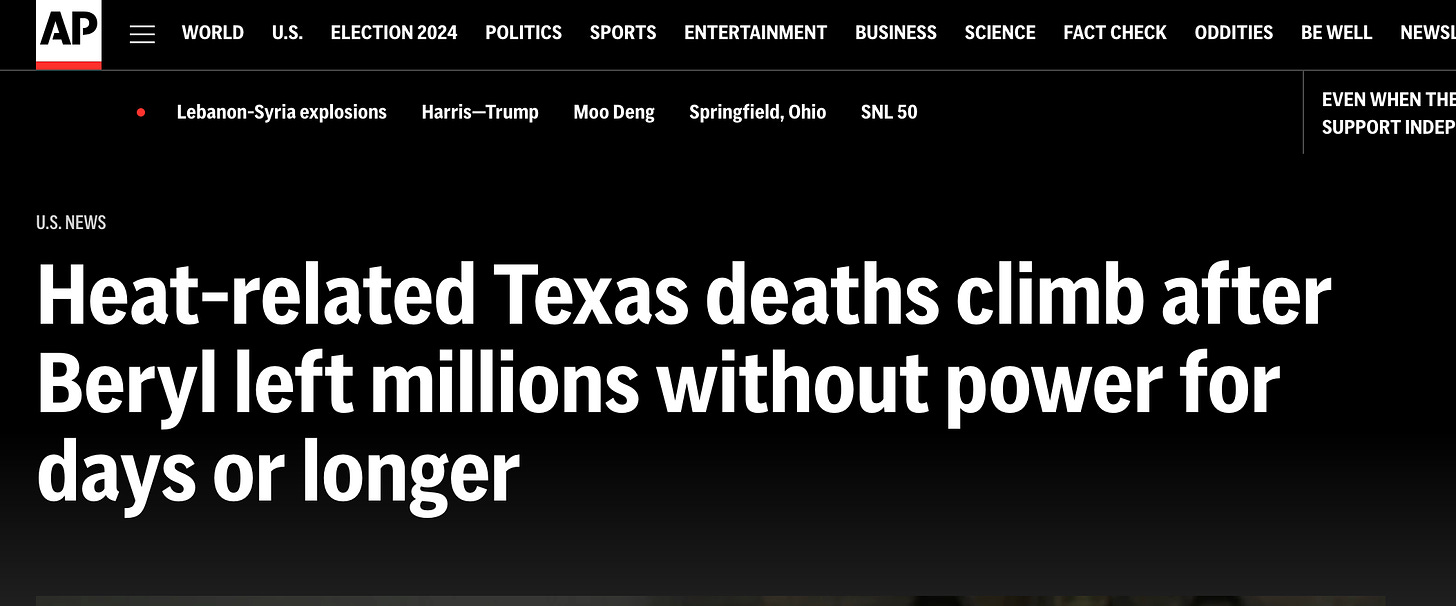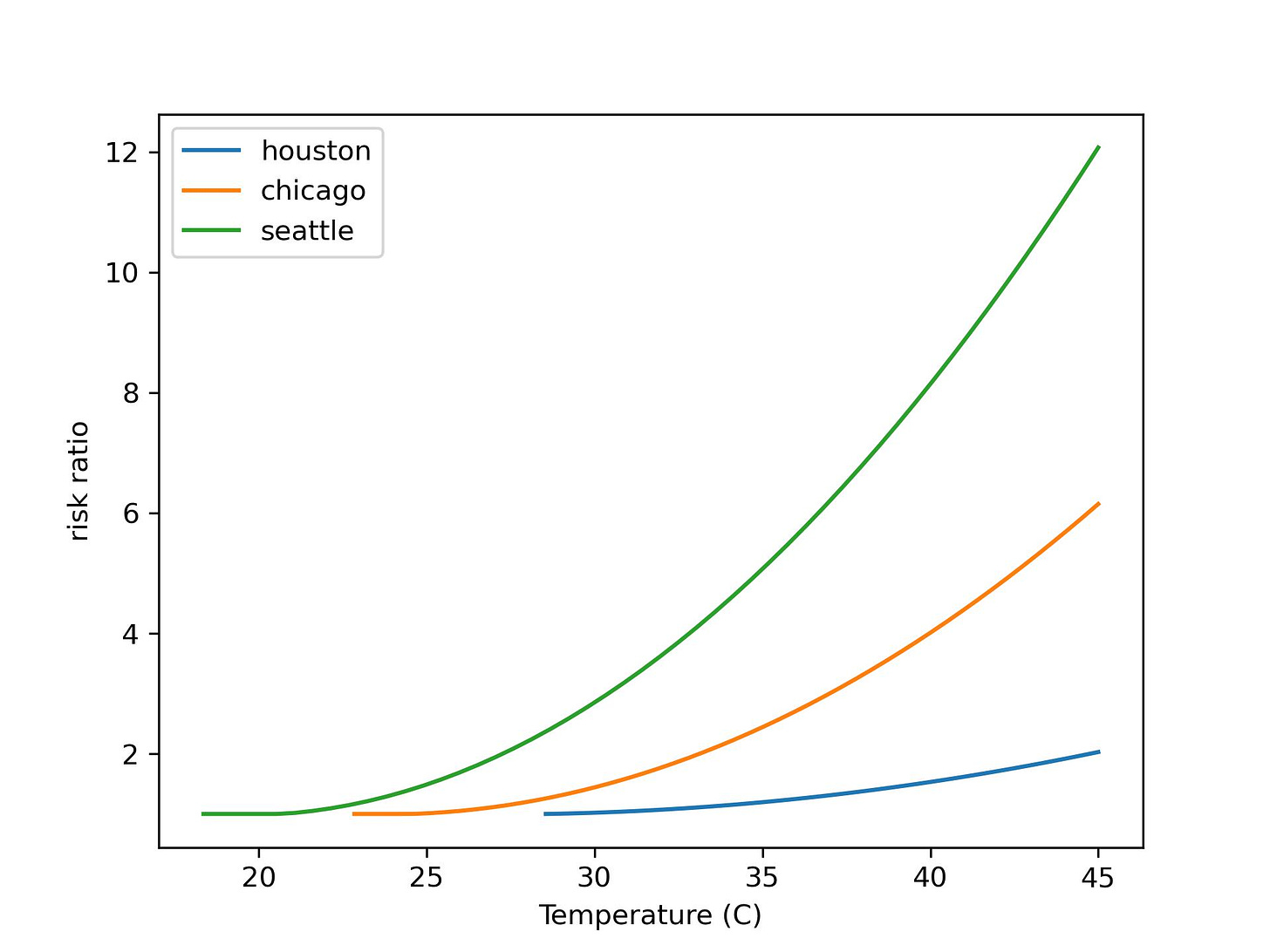
This is a re-post from The Climate Brink by Andrew Dessler
You should probably learn the term compound climate event. It refers to the occurrence of multiple weather- or climate-related hazards happening simultaneously or in close succession, leading to amplified impacts.
One of the most feared compound events is a hurricane causing massive infrastructure damage followed by extreme heat. If the damage caused a blackout, it could leave a huge population without access to air conditioning, leading to heat-related illnesses and fatalities.
This is far from a theoretical occurrence: It just happened in Houston when Hurricane Beryl hit the city, knocking out power for days.
Various news reports put the number of deaths due to Beryl at a few dozen. A third to half of these deaths have been attributed to extreme heat associated with the blackout. So maybe a dozen or so.
Is that estimate reasonable? Measuring heat-related deaths is challenging. When someone dies during a heatwave, the cause might be recorded as a heart attack, stroke, or respiratory failure, without acknowledging that heat played a role in triggering these conditions. This leads to chronic underestimations of the true toll of heat on public health.
Scientists have been studying mortality due to extreme heat for more than a decade and, in that time, the public health community has developed reasonably good statistical methodology for estimating how temperature affects death rates.
The statistical relation between extreme heat and mortality is expressed as a relative risk (RR) curve. Here are the RR curves for three cities, Houston, Chicago, and Seattle:

The RR curve has a value of 1 at the minimum mortality temperature (MMT) — this is the optimal temperature, where the death rate is the lowest. Chicago’s MMT is 23C, and let’s assume there are 100 deaths at that temperature.
The RR curve tells you how mortality increases with temperature, relative to the number of deaths at the MMT. For example, at 28C, Chicago’s RR value is 1.2, meaning there are 120 deaths at that temperature (1.2 times 100, the number of deaths at the MMT). From this, we conclude that increasing the temperature from 23C to 28C leads to 20 temperature-related deaths (120 minus 100).
We see that Houston’s RR curve is the lowest, meaning it has the fewest heat-related deaths, because the city experiences high temperatures regularly, so the city is well adapted to extreme heat. Just about everything in the city is air conditioned, and this lowers the risk of heat-related mortality during a heat wave.
Chicago’s curve is higher than Houston’s because, although it experiences hot summers, extreme heat events are less frequent, so the population is not as well-adapted to extreme heat.
Seattle has the highest RR curve because it typically has a cooler climate, and extreme heat events are rare. The population is even less adapted to high temperatures than Chicago, and the infrastructure — such as widespread air conditioning — may not be sufficiently deployed to handle sudden heat waves.
Hurricane Beryl caused a massive power outage, affecting most of the Houston metropolitan area at its peak on July 8, 2024. Over the following days, power was slowly restored. By July 10, about 2.3 million customers were still without power. On July 11, over 1 million customers were still in the dark. Hundreds of thousands remained without electricity even a week later, with about 10,000 outages persisting until July 18.
Without air conditioning, people experienced higher temperatures, and this certainly led to additional deaths. To estimate how many, I will make this bold assumption: without power, Houston’s RR curve will equal that of cities like Chicago or Seattle, which are not well adapted to heat.
To estimate this, I will take the daily average temperature for Houston for the days after Beryl and calculate the heat-related deaths using the Houston, Chicago, and Seattle RR curves. The differences, Chicago minus Houston and Seattle minus Houston, are estimates of the mortality due to the blackout:

To get a total for Beryl, I will further assume that Houston is 100% out of power for the first two days, then 50% out of power for the next three days, after which power is restored.
This yields 361 and 63 deaths due to the blackout.
Given the uncertainties, this should be viewed as an order-of-magnitude estimate, which is a rough calculation used to determine the general scale of the number. The goal is to figure out if heat-related mortality due to the blackout caused ones, tens, hundreds, thousands of deaths.
We conclude that the number of deaths is on the order of 100 (often written as O(100)) due to the blackout. The actual number might be 50, 200, or 300, but it’s probably not 10 or 1,000.
This is only the deaths due to heat. Total deaths will be larger because there are lots of ways the blackout can kill people other than extreme heat. For example, some people need electricity to run medical equipment (e.g., oxygen concentrators) and, when the power goes out, those people are in deep trouble.
Houston’s temperatures after Beryl were not particularly hot; daily average temperatures ranged from the mid to upper 20s Celsius. What would happen if we had experienced a really hot period?
One of the hottest 5-day periods in Texas occurred Aug. 7-11, 2011. If those temperatures had occurred after Beryl, there would have been a lot more death:

This yields estimates of 863 and 232 deaths due to the blackout using the two estimates. Again, this is an order-of-magnitude estimate, so take the exact numbers with a grain of salt.
A more reliable conclusion is that the number of deaths would be several times higher than we estimated occurred during Beryl. Thus, we did luck out, to some extent at least, and things could certainly have been worse.
There is a peer-reviewed study estimating deaths due to a blackout during a heatwave in Phoenix. They have a much more complicated way of figuring out how mortality changes, which I won’t explain here; read the paper if you’re interested. The Washington Post wrote about it here.
The analysis estimated that a Beryl-like 5-day blackout in Phoenix could kill more than 13,000 people. Phoenix regularly experiences summer highs that can reach above 45C, and without the cooling relief of air conditioning, indoor temperatures quickly rise to dangerous levels. This makes a blackout in Phoenix far deadlier than in places with milder climates, including Houston.
Using my analog-city method, I estimate that deaths would be 2,800 and 1,200 people, e.g., O(1,000) fatalities. Thus, I’m getting lower fatalities than this previous estimate. Nevertheless, it’s clear that this would be a mass-casualty event.
Ultimately, we don’t really know how many people will perish in a blackout during a heat wave. We simply don’t have the data to test our various estimates. In fact, we may not know exactly how bad it will be until it happens.
But one thing is clear: a lot of people will die.
It is also evident that the poorest and most vulnerable will bear the greatest suffering. With few resources, no means to evacuate, and no social network to lean on in moments of crisis, they stand most vulnerable in the face of climate catastrophe.
Here’s a TCB post explaining how we estimate the number of heat-related deaths. For more about why extreme heat is so deadly, check out this old TCB post.
Texas is undercounting heat-related deaths
Heat deaths in Texas are increasing rapidly
Jeff Goodell on blackouts after hurricanes, The heatwave scenario that keeps climate scientists up at night in the NYT.
How Blackouts during Heat Waves Amplify Mortality and Morbidity Risk by Stone et al. Here’s the Washington Post article about it.
Code to reproduce the plots and numbers
Posted by Guest Author on Monday, 30 September, 2024
 |
The Skeptical Science website by Skeptical Science is licensed under a Creative Commons Attribution 3.0 Unported License. |